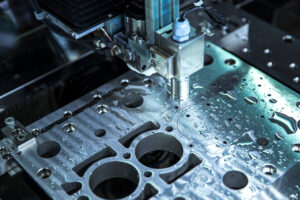CNC Machining: What It Is And How It Works

The early days of manufacturing mostly involved hard and intensive labour and time-consuming processes. This all changed with the introduction of certain technologies, like Computer Numerical Control (CNC) machining.
This was invented in 1952 and only became popular after 1967. It continues to become a vital piece in the manufacturing industry. Moreover, the global market of CNC machining is expected to surpass USD$25 billion by 2028.
What’s CNC Machining?
CNC machining is a subtractive type of manufacturing using pre-programmed codes dictating the movement of the CNC machines. It’s called a subtractive process since it uses CNC machines to remove layers of material to create the desired shape. In general, there are different types of CNC machines used, including mills, lathes, laser cutting, and plasma cutting machines.
In comparison to manual processes and other machining methods, CNC machining has proven to be more efficient, cost-effective, and ensure faster and more accurate production. This is why numerous industries, such as automotive, aerospace, construction, and industrial sectors rely heavily on CNC manufacturing services for prototyping, producing, and manufacturing necessary parts and components.
Parts Of A CNC Machine
Some parts of a CNC machine are:
Input Devices
This is where an operator inputs the part program in a CNC machine. In general, there are three types of input devices used:
Punch tape reader
Computer
Magnetic tape reader
Machine Control Unit (MCU)
The machine control unit is the most vital part of any CNC machine because it’s responsible for performing all the operations that a CNC machine can undertake. It scans the coded instructions and decrypts it after. It implements interpolation to generate axis motion commands, as well as feeds these commands into the amplifier circuits to drive the axis mechanisms.
In addition, the machine control unit receives feedback signals on the speed and position of each drive axis. It executes the auxiliary control tasks too, such as changing the tool or turning the spindle or coolant on and off.
By utilizing these machines, your business enhances efficiency and boosts productivity.
Machine Tool
The machine tool features a sliding table and a spindle to control the speed and position. Machine tables are controlled in X and Y-axis directions while the spindle is controlled in a Z-axis direction.
Feedback System
The feedback system consists of transducers acting as sensors. It continuously monitors the speed and position of the cutting tool and sends back a signal to the MCU.
Driving System
This part of CNC machines consists of drive motors, amplifier circuits, and ball lead screws. The MCU signals each machine’s axis. These control signals activate the drive motors which rotate the ball lead screw and position the machine table.
Display
Most machines today will feature a display unit or monitor that showcases the commands, programs, and other useful data of the CNC machine.
How Does CNC Machining Work?
CNC machining starts with a component design. A designer creates a 3D or 2D drawing of the prototype in Computer-Aided Design (CAD) software.
Once you have a design, the CAD files are converted into CNC-compatible files. In general, computer-aided manufacturing (CAM) software is used to change the CAD format into CNC codes.
The programming language used in CNC machining are:
G-code: Short for geometric code, it’s the code to control the movement and behaviours of the CNC machine, including speed and coordination.
M-code: M-code, also known as miscellaneous code or machine code, gives all information that a G-code overlooks, such as tool change, switch of coolant, or program stops.
The CNC codes are then loaded into the machine control unit of the CNC machine via the input device. The MCU processes the data and sends out motion commands and signals into the driving system. Then the drive system follows the signals and commands received to create the final designed component.
CNC machine also helps reduce error via the feedback system which records the movement and speed of the tools and sends feedback signals back to the MCU. From the original code signals, the MCU compares it against the received feedback signals to detect any error, correcting it accordingly and sending it back to the machine tool. This helps ensure precision and accuracy during operation.
Takeaway
The modern, industrial world is all about higher precision, increased efficiency, and greater speed— all of which could be provided by CNC machining. This technology has automated most activities of the manufacturing process, which has resulted in reduced manual labour and human error, ultimately increasing productivity in production.




